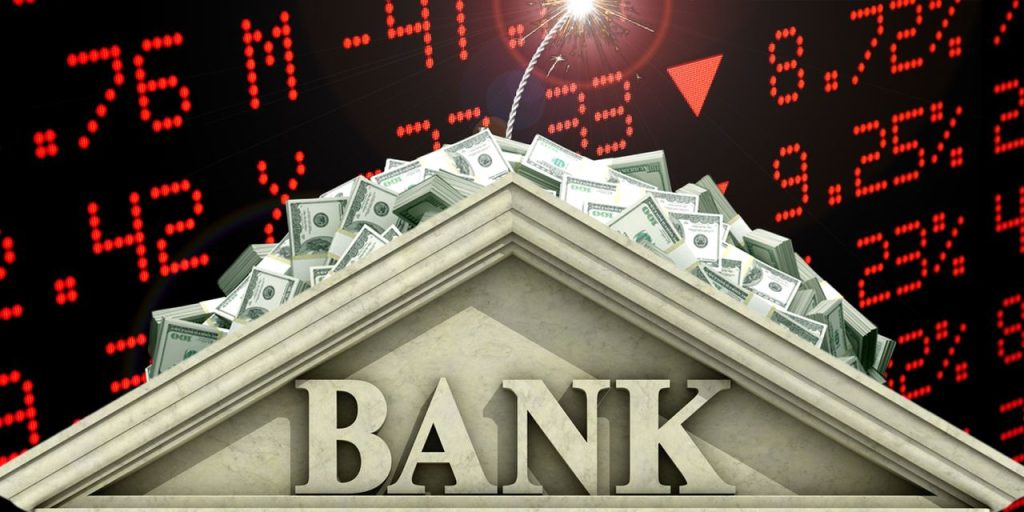Banks loaded up with U.S. government debt could face a reckoning if Washington’s debt-ceiling impasse spills over into a full-blown default.
Banks have become key buyers of Treasurys as a way to earn income on “risk-free” assets. Since the U.S. isn’t viewed as likely to default on its debts, banks don’t need to keep extra capital against them to offset potential losses. Regulators deem the debt a “zero percent” risk weight.
Lately, however, it’s been hard to dismiss Treasury Secretary Janet Yellen’s warning of “financial chaos” that could be unleashed without a deal in Washington, D.C., to increase the federal government’s $31.4 trillion borrowing limit. Yellen said on May 1 that the U.S. risks running short on funds as soon as June 1.
The debt-ceiling standoff comes at a precarious time for banks
KBE,
specifically regional lenders struggling to retain deposits, while looking to avoid forced sales of assets that have fallen in value as the Fed began to rapidly raise rates last year.
Related: U.S. could run out of cash ‘at some point in the first two weeks of June,’ CBO says
Market jitters around the impasse can be seen in short-term Treasurys. Democratic Rep. Sean Casten of Illinois on Wednesday pointed to the spread of more than 300 basis points between Treasurys coming due before and after the potential default date. His remarks came during a hearing on the federal response to recent bank failures.
The yield on 1-month Treasurys
TMUBMUSD01M,
was around 5.53% on Friday, while the 3-month
TMUBMUSD03M,
rate was pegged at 5.17%, according to FactSet. While banks have been encouraged by regulators to hold short-term Treasurys for liquidity needs, any holder forced to sell these securities into a volatile market could face painful losses.
See: Treasury bills, epicenter of market’s debt-ceiling worries, reflect doubts about a resolution
In addition, Casten suggested a U.S. default could leave more banks vulnerable to failure, particularly if risk weights on Treasurys were increased from zero. Assuming a 4% charge on $4 trillion of Treasurys, banks would need to raise about $160 billion to offset the exposure, the congressman’s office told MarketWatch after the hearing. That figure would increase to $320 billion based on a maximum 8% charge.
“The costs would be enormous,” said Brian Pillmore, founder of Visbanking, a platform for analyzing U.S. banks.
Pillmore was speaking both to the potential need for increased capitalization of banks if Treasury risk weights were increased, but also because bank holdings of government-backed securities would trade at a discount following a default.
Triple-A threat
The U.S. credit rating currently sits in the coveted triple-A category, with only S&P Global cutting its U.S. rating by a notch to AA+ in 2011 during an earlier debt-ceiling scare.
Mayra Rodriguez Valladares, a financial regulations expert and managing partner at MRV Associates, said any risk-weight change would hinge on how far U.S. credit ratings would drop following a default, but also that banks would have few good choices in that scenario.
“You can try to raise capital, which would be horrifying in the middle of a default, or you can try to jettison riskier assets like securitizations or other investments that require more capital,” Rodriguez Valladares said. “It is just uncharted territory.”
Avoiding fire sales
The U.S. government’s response to the COVID crisis led to a surge in bank deposits, which many lenders used to originate mortgages at ultralow rates or invested in low-yielding bonds with government backing.
Then came the quickest pace of Fed rate hikes since the 1970s and 80s. “In this environment, there’s going to be super stress in the banking system,” said Keith Noreika, a former acting comptroller for the Office of the Comptroller of the Currency. “Banks are in it for the long-term, but have to fund themselves in the short-term.”
Noreika, now chairman of the banking supervision and regulation group at consulting firm Patomak Global Partners, doesn’t see a default as likely or a change in Treasury risk weights, given that the Greek debt crisis a decade ago didn’t result in higher risk weights for that nation’s debt.
He does worry, however, about wild swings in short-term Treasury yields that could further destabilize banks, the longer it takes to reach a debt-limit deal.
Also, in a long shot scenario where the U.S. doesn’t pay off its maturing short-term Treasurys, he wouldn’t rule out forced sales of assets by banks needing liquidity.
“If a bank needs to sell at a fire sale price it could be forced into a Silicon Valley Bank situation, even though it tried to plan not to be,” he said.
Read the full article here
